Exploring Usability, Emotional Responses, Flow Experience, and Technology Acceptance in VR: A Comparative Analysis of Freeform Creativity and Goal-Directed Training
Abstract
1. Introduction
- Comparison: To develop virtual motivational interface prototypes for freeform creativity and goal-directed training, aligning with different task goals of exploration and browsing and goal-directed guidance, and to compare the distinct characteristics of these two interaction types;
- Testing: To compare the usability, emotional responses, flow experience, technology acceptance, user satisfaction, and effectiveness in promoting physical activities between the two VR types;
- Recommendations: To evaluate user characteristics associated with the use of freeform creativity and goal-directed training VR interfaces and to propose practical design recommendations based on the findings. These findings will serve as a reference for both academic research in VR and the VR design industry.
2. Literature Review
2.1. VR Elements and Flow Experience
2.2. VR Development Software (Unity) and VR Creation Software (Gravity Sketch)
2.3. VR Usability Testing and QUIS
2.4. Emotional Responses and the Self-Assessment Manikin Emotion Scale
2.5. Technology Acceptance Model
- 1.
- Perceived usefulness:This refers to the extent to which a user subjectively believes that employing a particular system enhances job performance. When users perceive that the system is easy to use, the users may be inclined to accomplish more tasks with the same level of effort. Thus, this belief is simultaneously influenced by perceived ease of use and external variables;
- 2.
- Perceived ease of use:This indicates the degree to which a user believes that using a particular system would require minimal effort;
- 3.
- Perceived enjoyment:This refers to the extent to which the use of information technology is perceived as enjoyable and interesting;
- 4.
- Attitude toward use:User attitude toward the use of information technology is influenced by both perceived usefulness and perceived ease of use;
- 5.
- Behavioral intention to use:The decision to use an information system is determined by the behavioral intention, which is influenced by the user’s attitude toward technology use and perceived usefulness.
3. Research Methods
3.1. Research Design, Subjects, and Materials
- At the beginning, the instructor initiated the VR equipment and introduced the experiment’s precautions and tasks and participants filled out the consent form. This step took about 5 min. Subsequently, the instructor asked participants to put on the VR equipment, addressed any wearing issues, and ensured that participants correctly donned the VR equipment. Under the instructor’s guidance, participants began to familiarize themselves with the VR operations, gradually adapting to the VR equipment. The instructor answered questions and resolved issues during this step, which took about 10 min;
- Participants in the “Freeform Creativity” group used the Gravity Sketch program to freely create for 10 minutes, using a virtual brush to draw anything they preferred. The instructor guided participants in simulating a brush with the controller, using buttons to draw lines, change colors, and depict desired plants or animals;
- In the “Goal-Directed Training” experimental group, participants operated a dumbbell challenge exercise program designed with Unity. Participants were required to complete three specified tasks within 10 min. These tasks included the following: (a) picking up the controller (virtual dumbbell), (b) selecting a level, and (c) completing at least one exercise cycle within the allotted time. The exercise cycle comprised five levels, each involving simple dumbbell stretching exercises performed in five different postures;
- After completing the above steps, participants filled out a questionnaire and participated in a semi-structured interview.
3.2. Questionnaire Design
4. Results
4.1. Mean and Standard Deviation for Each Scale
4.2. Analysis Results of Each Scale
4.2.1. Emotional Responses
4.2.2. Usability
4.2.3. Flow Experience
4.2.4. TAM
4.2.5. User Activity Effectiveness, Preference, and Satisfaction
5. Discussion
5.1. Main Findings
5.2. Practical Implications
5.3. Conclusions
Funding
Institutional Review Board Statement
Informed Consent Statement
Data Availability Statement
Conflicts of Interest
References
- Tussyadiah, I.P.; Wang, D.; Jung, T.H.; Dieck, M.C.T. Virtual reality, presence, and attitude change: Empirical evidence from tourism. Tour. Manag. 2018, 66, 140–154. [Google Scholar] [CrossRef]
- Diemer, J.; Alpers, G.W.; Peperkorn, H.M.; Shiban, Y.; Mühlberger, A. The impact of perception and presence on emotional reactions: A review of research in virtual reality. Front. Psychol. 2015, 6, 26. [Google Scholar] [CrossRef]
- Fang, Y.M.; Huang, Y.J. Comparison of the Usability and Flow Experience of an Exercise Promotion Virtual Reality Program for Different Age Groups. Behav. Inf. Technol. 2021, 40, 1250–1264. [Google Scholar] [CrossRef]
- Fang, Y.M.; Kao, T.L. Comparisons of Emotional Responses, Flow Experiences, and Operational Performances in Traditional Parametric Computer-Aided Design Modeling and Virtual-Reality Free-Form Modeling. Appl. Sci. 2023, 13, 6568. [Google Scholar] [CrossRef]
- Fang, Y.M.; Lin, C. The Usability Testing of VR Interface for Tourism Apps. Appl. Sci. 2019, 9, 3215. [Google Scholar] [CrossRef]
- Krueger, M.K. Artificial Reality II; Addison-Wesley Professional: Boston, MA, USA, 1991. [Google Scholar]
- Vafadar, M. Virtual reality: Opportunities and challenges. Int. J. Mod. Eng. Res. (IJMER) 2013, 3, 1139–1145. [Google Scholar]
- Csikszentmihalyi, M.; Csikszentmihalyi, I. Beyond Boredom and Anxiety; Jossey-Bass: San Francisco, CA, USA, 1975. [Google Scholar]
- Mcmahan, R.P.; Bowman, A.; Zielinski, D.J. Evaluating display fidelity and interaction fidelity in a virtual reality game. IEEE Trans. Vis. Comput. Graph. 2012, 18, 626–633. [Google Scholar] [CrossRef] [PubMed]
- Bowman, D.A.; McMahan, R. Virtual Reality: How Much Immersion is Enough? Computer 2007, 40, 36–43. [Google Scholar] [CrossRef]
- Reid, D. A Model of Playfulness and Flow in Virtual Reality Interactions. Presence Teleoperators Virtual Environ. 2004, 13, 451–462. [Google Scholar] [CrossRef]
- Csikszentmihalyi, M.; Csikszentmihalyi, I.S. (Eds.) Optimal Experience: Psychological Studies of Flow in Consciousness; Cambridge University Press: Cambridge, UK, 1992. [Google Scholar]
- Novak, T.P.; Hoffman, D.L.; Yung, Y.F. Measuring the Customer Experience in Online Environments: A Structural Modeling Approach. Mark. Sci. 2000, 19, 22–42. [Google Scholar] [CrossRef]
- Han, S. -L.; An, M.; Han, J.J.; Lee, J. Telepresence, Time Distortion, and Consumer Traits of Virtual Reality Shopping. J. Bus. Res. 2020, 118, 311–320. [Google Scholar] [CrossRef]
- Pelet, J.-É.; Ettis, S.; Cowart, K. Optimal experience of flow enhanced by telepresence: Evidence from social media use. Inf. Manag. 2017, 54, 115–128. [Google Scholar] [CrossRef]
- França, A.C.P. de, J. Neto, P.; Soares, M.M. Methods and Procedures to Usability Testing in Virtual Reality Systems. In Advances in Ergonomics in Design, Proceedings of the AHFE 2017 International Conference on Ergonomics in Design, Los Angeles, CA, USA, 17–21 July 2017; Springer: Cham, Switzerland, 2018; pp. 45–51. [Google Scholar]
- Chalil, M.K.; Greenstein, J.S. An investigation of the efficacy of collaborative virtual reality systems for moderated remote usability testing. Appl. Ergon. 2017, 65, 501–514. [Google Scholar] [CrossRef] [PubMed]
- Hald, K.; Rehm, M.; Moeslund, T.B. Testing Augmented Reality Systems for Spotting Sub-Surface Impurities. In Proceedings of the IFIP Working Conference on Human Work Interaction Design, Proceedings of 5th IFIP WG 13.6 Working Conference, HWID 2018, Espoo, Finland, 20–21 August 2018; Springer: Cham, Switzerland, 2019; pp. 103–112. [Google Scholar]
- Liu, Y.F.; Yang, N.; Li, A.; Paterson, J.; McPherson, D.; Cheng, T.; Yang, A.Y. Usability Evaluation for Drone Mission Planning in Virtual Reality. In Proceedings of the International Conference on Virtual, Augmented and Mixed Reality, Las Vegas, NV, USA, 15–20 July 2018; Springer: Cham, Switzerland, 2018; pp. 313–330. [Google Scholar]
- AlFalah, S.F.; Harrison, D.K.; Charissis, V.; Evans, D. An investigation of a healthcare management system with the use of multimodal interaction and 3D simulation: A technical note. J. Enterp. Inf. Manag. 2013, 26, 183–197. [Google Scholar] [CrossRef]
- Tullis, T.S.; Stetson, J.N. A Comparison of Questionnaires for Assessing Website Usability. In Proceedings of the Usability Professionals Association (UPA) 2004 Conference, Minneapolis, MN, USA, 7–11 June 2004. [Google Scholar]
- Chin, J.P.; Diehl, V.A.; Norman, K.L. Development of an instrument measuring user satisfaction of the human-computer interface. In Proceedings of the SIGCHI Conference on Human Factors in Computing Systems, Washington, DC, USA, 15–19 May 1988; ACM: New York, NY, USA, 1988; pp. 213–218. [Google Scholar]
- Hodes, R.L.; Cook, E.W.; Lang, P.J. Individual differences in autonomic response: Conditioned association or conditioned fear? Psychophysiology 1985, 22, 545–560. [Google Scholar] [CrossRef] [PubMed]
- Wundt, W. Lectures on Human and Animal Psychology; Creighton, J.E.; Titchener, E.B., Translators; Aberdeen University Press: Aberdeen, UK, 1894. [Google Scholar]
- Bradley, M.M.; Lang, P.J. Measuring emotion: The self-assessment manikin and the semantic differential. J. Behav. Ther. Exp. Psychiatry 1994, 25, 49–59. [Google Scholar] [CrossRef] [PubMed]
- Hadley, C.B.; Mackay, D.G. Does emotion help or hinder immediate memory? Arousal versus priority-binding mechanisms. J. Exp. Psychol. Learn. Mem. Cogn. 2006, 32, 79. [Google Scholar] [CrossRef] [PubMed]
- Vallerand, R.J.; Deshaies, P.; Cuerrier, J.P.; Pelletier, L.G.; Mongeau, C. Ajzen and Fishbein’s theory of reasoned action as applied to moral behavior: A confirmatory analysis. J. Personal. Soc. Psychol. 1992, 62, 98. [Google Scholar] [CrossRef]
- Lala, G. The emergence and development of the technology acceptance model (TAM). In Proceedings of the Marketing from Information to Decision, Cluj-Napoca, Romania, 7–8 November 2014; pp. 149–160. [Google Scholar]
- Abdullah, F.; Ward, R.; Ahmed, E. Investigating the influence of the most commonly used external variables of TAM on students’ Perceived Ease of Use (PEOU) and Perceived Usefulness (PU) of e-portfolios. Comput. Hum. Behav. 2016, 63, 75–90. [Google Scholar] [CrossRef]
- Hess, T.J.; McNab, A.L.; Basoglu, K.A. Reliability generalization of perceived ease of use, perceived usefulness, and behavioral intentions. MIS Q. 2014, 38, 1–28. [Google Scholar] [CrossRef]
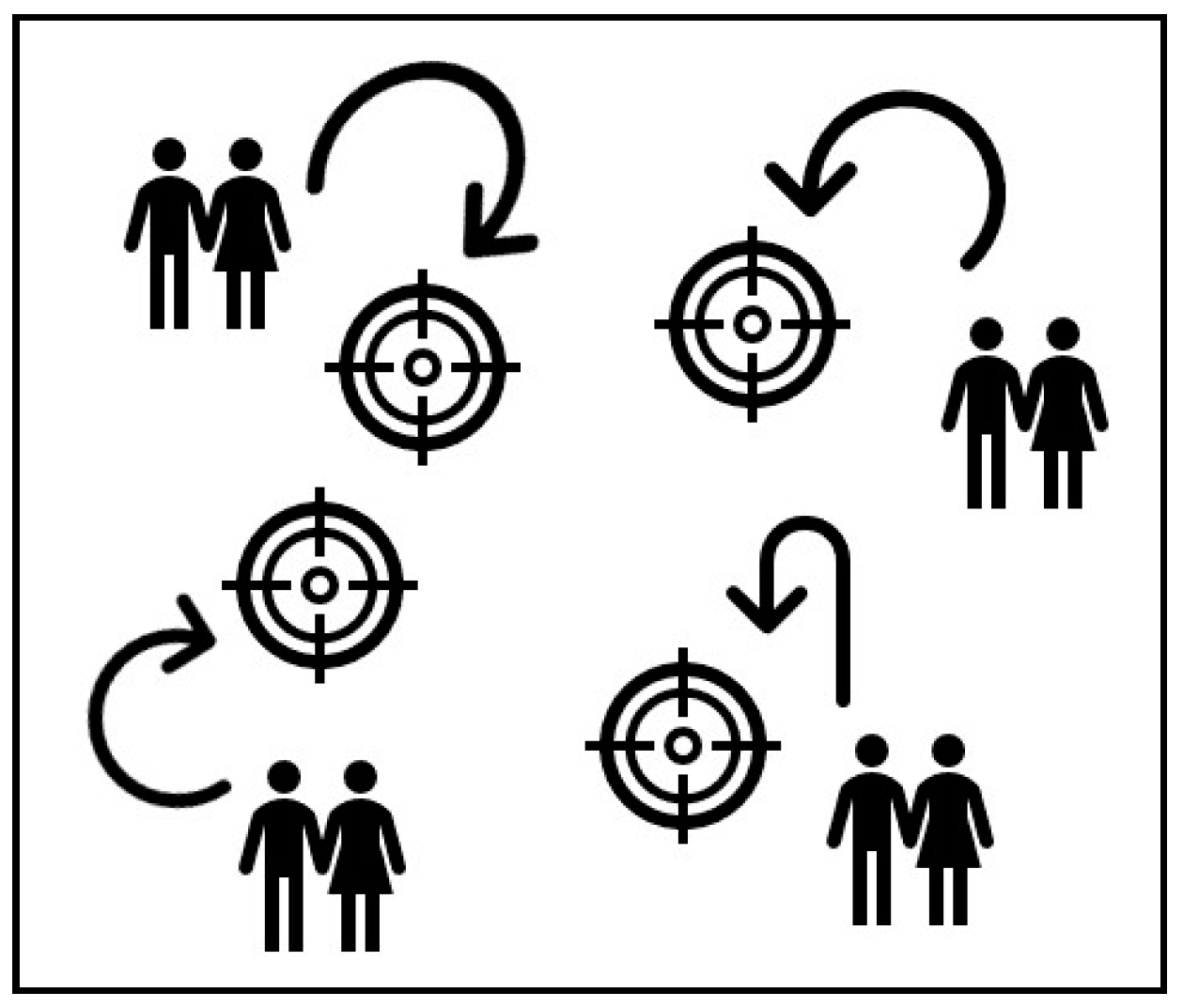
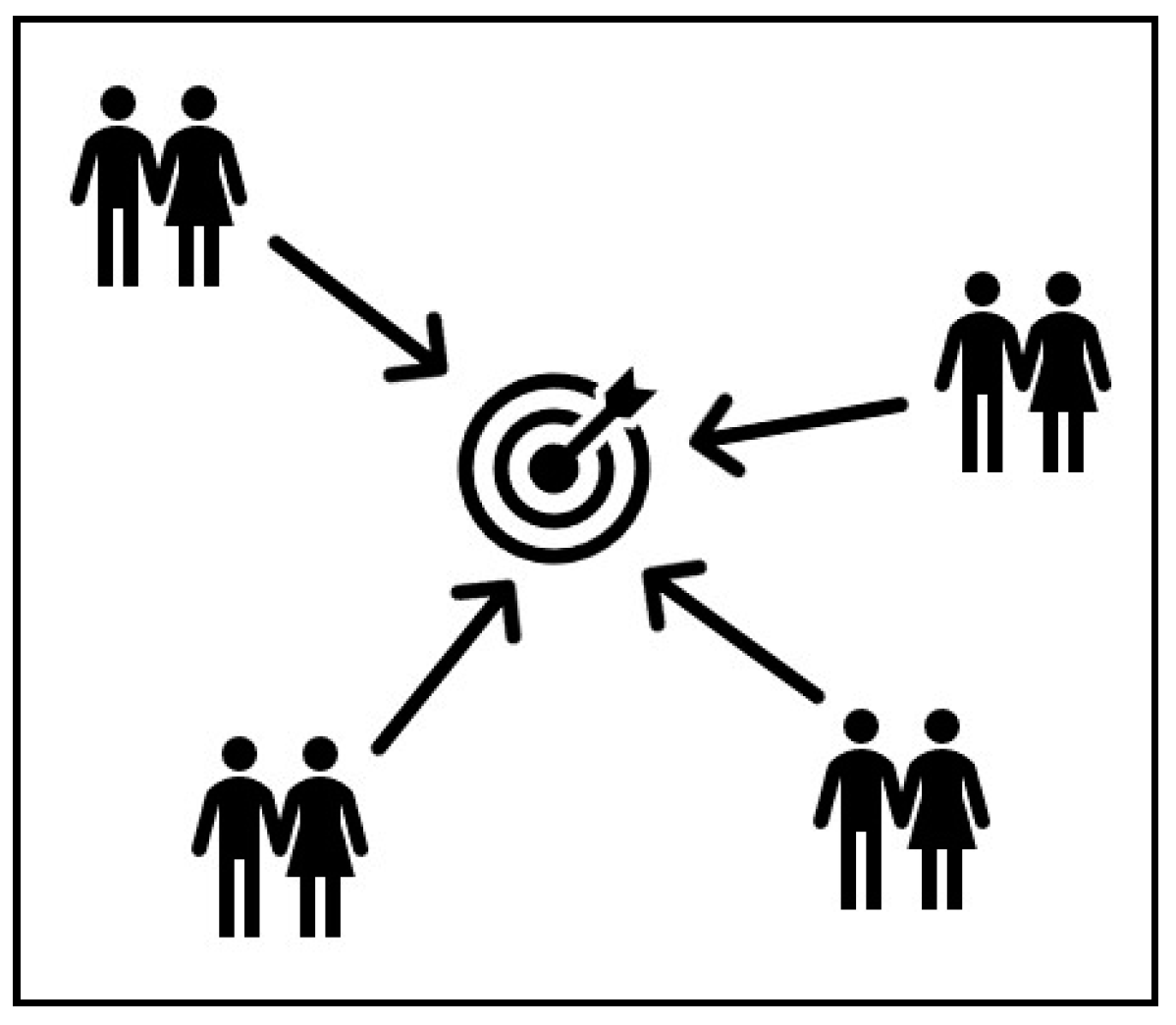


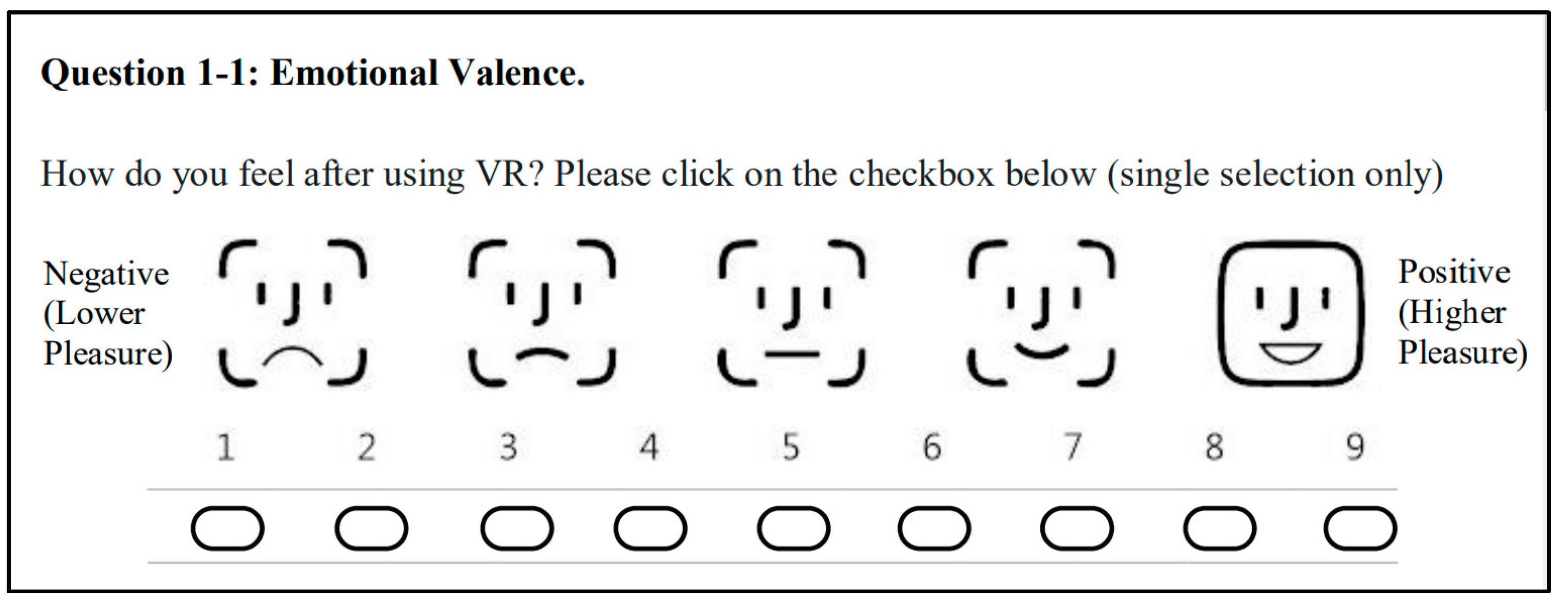
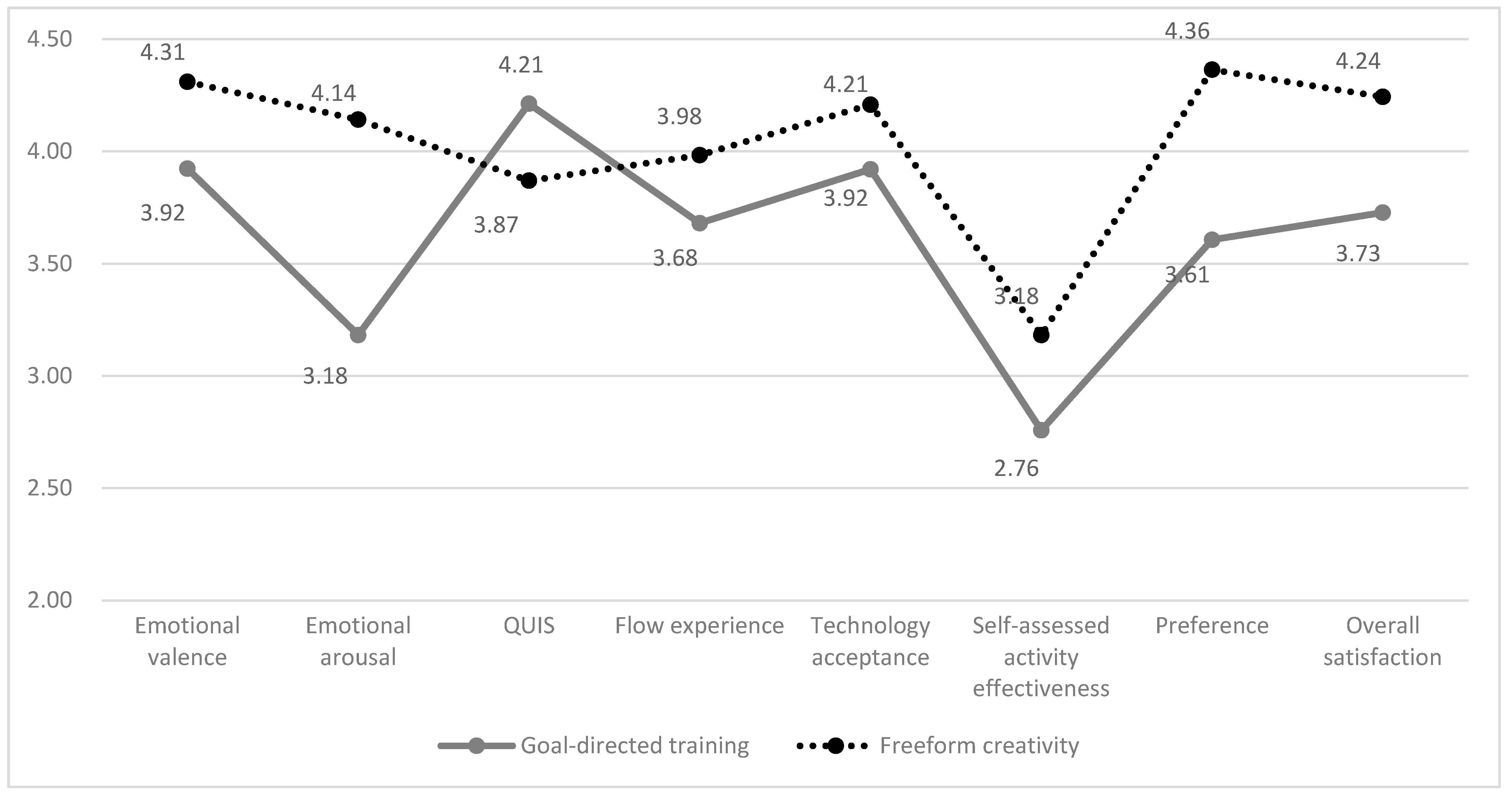
| Interface Type | Freeform Creativity | Goal-Directed Training |
|---|---|---|
| Characteristic | Exploration and browsing | Goal-directed guidance |
| Content | Creative expression and free exploration | Learning operations, goal confirmation, and task completion |
| Tasks |
|
|
| Operation interface | 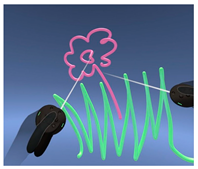 | 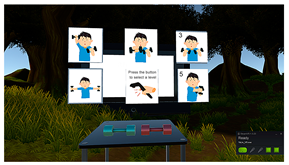 |
| Software | Gravity Sketch (6.0) | VR dumbbell challenge exercise program designed using Unity (2023.2.0b17) |
| Execution platform | SteamVR platform operated on Microsoft Windows 10 | |
| On-site experimental setup and usage by participants | 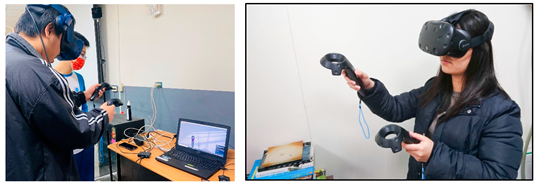 | |
| VR interaction equipment | HTC Vive Pro VR headset, controllers, and base stations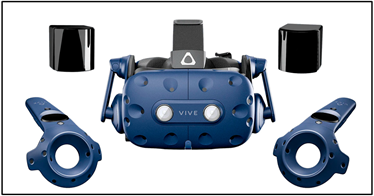 | |
| Display and operation devices | Asus ROG laptop operated by the tester with a 15.6-inch Full HD Display, Intel Core i7-7700HQ Processor, and NVidia GTX 1060-6G (Taipei, Taiwan). | |
| Section | Questionnaire Item | Number of Items | Scale Type | Questionnaire Content and Objective |
|---|---|---|---|---|
| 1. Users’ emotional responses | Emotional valence | 1 | 9-point semantic differential scale | To assess the level of pleasure experienced |
| Emotional arousal | 1 | 9-point semantic differential scale | To evaluate the intensity of emotion felt | |
| 2. QUIS | 1. Overall response | 4 | 5-point semantic differential scale | To evaluate the overall response to the interface and the intensity of feeling |
| 2. Interface representation | 3 | 5-point semantic differential scale | To evaluate the readability, function framework, and continuity | |
| 3. Interface information | 3 | 5-point semantic differential scale | To assess the presentation and clarity of information and system prompts | |
| 4. Interface learnability | 3 | 5-point semantic differential scale | To determine the correct methods, remember names and functions, ease of task implementation | |
| 3. Flow experience | 1. Concentration | 4 | 5-point Likert scale | To measure the concentration, engagement, and the ability to remain undistracted |
| 2. Enjoyment | 4 | 5-point Likert scale | To evaluate enjoyment, entertainment value, stimulation, and novelty | |
| 3. Sense of time distortion | 4 | 5-point Likert scale | To assess the sense of time passage and the ability to forget troubles and pending tasks | |
| 4. Control | 2 | 5-point Likert scale | To determine the sense of control and the ability to cope with sudden changes | |
| 4. Technology acceptance | 1. Perceived usefulness | 3 | 5-point Likert scale | To assess enjoyment in the process, perceived usefulness, and desire for the technology |
| 2. Perceived ease of use | 2 | 5-point Likert scale | To evaluate the ease of understanding and use | |
| 3. Perceived enjoyment | 3 | 5-point Likert scale | To assess fun and pleasure experienced during use | |
| 4. Attitude toward use | 2 | 5-point Likert scale | To measure the level of enjoyment in engaging with the technology | |
| 5. Behavioral intention to use | 2 | 5-point Likert scale | To determine the perceived worthiness of engagement and the likelihood of future use | |
| 5. Self-assessed activity effectiveness | 1 | 5-point semantic differential scale | To assess activity effectiveness based on experience | |
| 6. Preference | 1 | 5-point semantic differential scale | To evaluate the level of preference | |
| 2 | Short-answer questions | To investigate the reasons for likes and dislikes | ||
| 7. Overall satisfaction | 1 | 5-point semantic differential scale | To determine the level of satisfaction | |
| 8. Reasons for interface advantages and disadvantages | Reasons and opinions on interface advantages | 1 | Brief-description questions | To conduct semistructured interviews inquiring about the reasons and opinions on the interface advantages |
| Reasons and opinions on interface disadvantages | 1 | Brief-description questions | To conduct semistructured interviews inquiring about the reasons and opinions on the interface disadvantages | |
| 9. Personal information | Participant demographics | 3 | Short-answer questions | To gather information on age and gender |
| Participant background | 3 | 5-point Likert scale | To gather information on the exercise frequency and experience with computer drawing software and VR software use | |
| Item | Goal-Directed Training | Freeform Creativity | ||
|---|---|---|---|---|
| Mean | SD | Mean | SD | |
| Emotional valence | 3.92 | 0.96 | 4.31 | 0.92 |
| Emotional arousal | 3.18 | 1.25 | 4.14 | 0.86 |
| QUIS | 4.21 | 0.48 | 3.87 | 0.69 |
| Flow experience | 3.68 | 0.68 | 3.98 | 0.55 |
| Technology acceptance | 3.92 | 0.76 | 4.21 | 0.66 |
| Self-assessed activity effectiveness | 2.76 | 1.37 | 3.18 | 1.29 |
| Preference | 3.61 | 1.06 | 4.36 | 0.74 |
| Overall satisfaction | 3.73 | 0.91 | 4.24 | 0.75 |
| Pairwise Comparison (Goal-Directed Training vs. Freeform Creativity) | Paired Variable Difference | T Value | Significance (Two-Tailed) | ||||
|---|---|---|---|---|---|---|---|
| Comparison of Mean | SD | Standard Error of the Mean | 95% Confidence Interval of Difference | ||||
| Lower Bound | Upper Bound | ||||||
| Emotional responses | |||||||
| Emotional valence | (0.70) | 1.93 | 0.34 | (1.38) | (0.01) | (2.08) | 0.046 * |
| Emotional arousal | (1.73) | 2.11 | 0.37 | (2.48) | (0.98) | (4.70) | 0.000 * |
| Usability | |||||||
| Overall response | (0.29) | 0.75 | 0.13 | (0.55) | (0.02) | (2.20) | 0.035 * |
| Representation | 0.47 | 0.87 | 0.15 | 0.17 | 0.78 | 3.13 | 0.004 * |
| Information | 0.06 | 0.58 | 0.10 | (0.15) | 0.27 | 0.60 | 0.553 |
| Learnability | 0.82 | 0.74 | 0.13 | 0.56 | 1.08 | 6.38 | 0.000 * |
| Total QUIS score | 0.34 | 0.56 | 0.10 | 0.14 | 0.54 | 3.51 | 0.001 * |
| Flow experience | |||||||
| Concentration | (0.45) | 0.67 | 0.12 | (0.68) | (0.21) | (3.85) | 0.001 * |
| Enjoyment | (0.59) | 0.81 | 0.14 | (0.88) | (0.30) | (4.21) | 0.000 * |
| Sense of time distortion | (0.32) | 0.64 | 0.11 | (0.54) | (0.09) | (2.86) | 0.007 * |
| Control | 0.17 | 0.83 | 0.14 | (0.13) | 0.46 | 1.16 | 0.255 |
| Total flow experience score | (0.30) | 0.46 | 0.08 | (0.46) | (0.13) | (3.71) | 0.001 * |
| Technology acceptance | |||||||
| Perceived usefulness | (0.57) | 1.15 | 0.20 | (0.97) | (0.16) | (2.83) | 0.008 * |
| Perceived ease of use | 0.56 | 0.83 | 0.14 | 0.27 | 0.85 | 3.89 | 0.000 * |
| Perceived enjoyment | (0.43) | 0.82 | 0.14 | (0.73) | (0.14) | (3.03) | 0.005 * |
| Attitude toward use | (0.35) | 1.09 | 0.19 | (0.73) | 0.04 | (1.84) | 0.075 |
| Behavioral intention to use | (0.65) | 0.96 | 0.17 | (0.99) | (0.31) | (3.88) | 0.000 * |
| Total TAM score | (0.29) | 0.76 | 0.13 | (0.56) | (0.02) | (2.18) | 0.036 * |
| Self-assessed activity effectiveness, preference, and satisfaction | |||||||
| Self-assessed activity effectiveness | (0.42) | 1.44 | 0.25 | (0.93) | 0.09 | (1.70) | 0.100 |
| Preference | (0.76) | 1.23 | 0.21 | (1.19) | (0.32) | (3.55) | 0.001 * |
| Satisfaction | (0.52) | 1.00 | 0.17 | (0.87) | (0.16) | (2.95) | 0.006 * |
| VR Interaction Type | Reason for Liking | Reason for Disliking |
|---|---|---|
| Goal-directed training |
|
|
| Freeform creativity |
|
|
Disclaimer/Publisher’s Note: The statements, opinions and data contained in all publications are solely those of the individual author(s) and contributor(s) and not of MDPI and/or the editor(s). MDPI and/or the editor(s) disclaim responsibility for any injury to people or property resulting from any ideas, methods, instructions or products referred to in the content. |
© 2024 by the author. Licensee MDPI, Basel, Switzerland. This article is an open access article distributed under the terms and conditions of the Creative Commons Attribution (CC BY) license (https://creativecommons.org/licenses/by/4.0/).
Share and Cite
Fang, Y.-M. Exploring Usability, Emotional Responses, Flow Experience, and Technology Acceptance in VR: A Comparative Analysis of Freeform Creativity and Goal-Directed Training. Appl. Sci. 2024, 14, 6737. https://doi.org/10.3390/app14156737
Fang Y-M. Exploring Usability, Emotional Responses, Flow Experience, and Technology Acceptance in VR: A Comparative Analysis of Freeform Creativity and Goal-Directed Training. Applied Sciences. 2024; 14(15):6737. https://doi.org/10.3390/app14156737
Chicago/Turabian StyleFang, Yu-Min. 2024. "Exploring Usability, Emotional Responses, Flow Experience, and Technology Acceptance in VR: A Comparative Analysis of Freeform Creativity and Goal-Directed Training" Applied Sciences 14, no. 15: 6737. https://doi.org/10.3390/app14156737
APA StyleFang, Y.-M. (2024). Exploring Usability, Emotional Responses, Flow Experience, and Technology Acceptance in VR: A Comparative Analysis of Freeform Creativity and Goal-Directed Training. Applied Sciences, 14(15), 6737. https://doi.org/10.3390/app14156737






